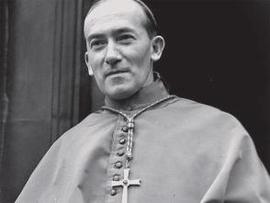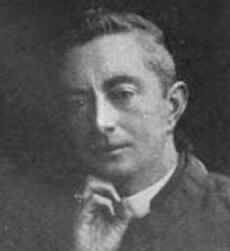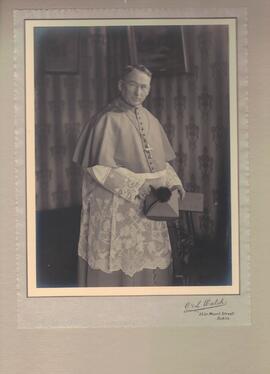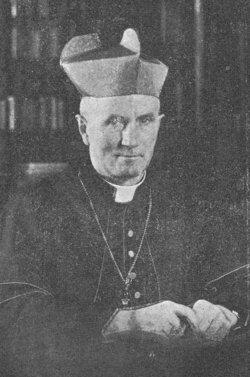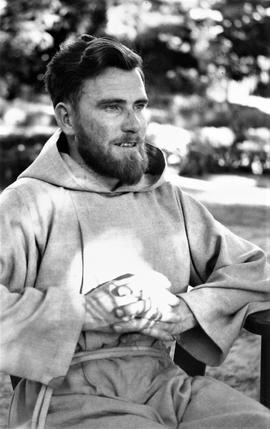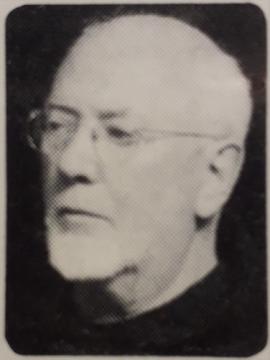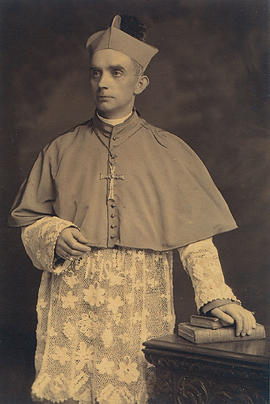Patrick Morrisroe the son of Mary Brennan and John Morrisroe (the baker) was born in Charlestown, County Mayo 19th February 1867. His sponsors were Luke Brennan and Frances Kelly. He joined several siblings. As seemed to follow family suit, he was educated at the local N.S. Seminary, then on to Ballaghadereen and Maynooth College. Following his ordination at the Cathedral at Ballaghadereen he served in the diocese of Achonry. In 1896 Patrick returned to Maynooth to become Junior Dean in the College.
CathedralPatrick was consecrated a Bishop at the age of 44 in the Cathedral, Ballaghadereen along with his cousin Most Rev. Bishop Michael J. O'Doherty, later to become Bishop of Zamboagna, in the Philippines. Most Rev. Dr. Healy, Archbishop of Tuam was the concecrating prelate, and was assisted by Rev. Dr. Clancy, the Bishop of Elphin. The congregation which filled the Cathedral included Messrs. John Dillon M.P., J. McVeagh M.P., and John O'Dowd M.P. The sermon was preached by Rev. Dr. Beechler, Maynooth College.
A man of deep learning Patrick was an authority on theological and liturgical matters. His Lenten Pastoral of 1941, one of great controversy was censored by the government. There are two versions of the Pastoral, one before censorship and one after. In it he directs his final comments to a world in crisis. "As we pen these pages, beloved Brethren, we are face to face with a spectacle probably more appaling than any recorded in the annals of history. Long ago it was predicted that nation would rise agains nation and Kingdom against Kingdom."
At the age of 79 Patrick died at the Palace, Edmondstown House, Ballaghadereen. Priests and people from all parts of the Diocese of Achonry and from around the world attended the removal of the remains to St. Nathy's Cathedral. The Archbishop of Tuam, Most Rev. Dr. Walsh officiated at the house. The funeral procession was headed by the members of the Diocesan Chapter and a large number of surpliced clergy of the diocese who chanted the Miserere. Members of the St. Vincent de Paul and Gardai acted as pall-bearers and marshals, and gardai, under the direction of Supt. J. Lyons provided a guard of honour. Members off all the Catholic organizations marched in the procession. His crypt is located within the sanctuary.
Taken from - https://freepages.rootsweb.com/~morrisroe/genealogy/notjustacouple.html
See also https://www.catholic-hierarchy.org/bishop/bmorr.html
Mulvany was born in the townland of Skearke Moynalty, County Meath on the 1 March 1864 to James Mulvany and Mary Monaghan. He was ordained a priest of the Diocese of Meath on 6 March 1892.
Following his predecessors death, Pope Pius XI named him Bishop of Meath on 12 April 1929 and he was consecrated on 30 June of that year, with Cardinal Joseph MacRory being the principal consecrator. He retained that position until his death in Mullingar on 16 November 1943.He died in the Bishops Palace, Mullingar, and is buried in the Cathedral grounds.
New cathedral
At the time of his appointment, Mulvany became involved with plans for a new cathedral for Mullingar and the Diocese of Meath to replace the aging Cathedral of the Immaculate Conception (1836–1936). He took the plans to Pope Pius XI, who was supportive and requested that the new building be dedicated as The Cathedral of Christ the King.The building was completed from 1932 - 1936.
Mulvany opened St. Patrick's Classical School Navan in the former study hall of St. Finians College, Navan (which had moved to Mullingar).
Born at Grange, Fedamore, Co. Limerick, he was educated at St Munchin's College, Limerick and St Patrick's College Maynooth. Ordained priest in June 1915, he returned to Maynooth to prepare for a Doctorate in Divinity. He was appointed to the staff of Maynooth, and held the post of Professor of Moral Theology before becoming Vice-President of the College in 1936. He became PP Bruff and St Munchin's before he was appointed bishop in December 1945. He was consecrated bishop of Limerick on February 24th 1946.
Bishop O'Neill prepared the ground for the development of St Munchin's College and moved the Bishop's residence to Kilmoyle. Despite being a shy person, he was the driving force behind a great deal of Diocesan work. He died suddenly in Kilmoyle on March 26th 1958 and is buried in the priests' plot in Mount St Laurence Cemetery.
https://limerickdioceseheritage.org/Diocese/FormerBishops/PatrickONeil.htm
Baptismal name: James Brady
Religious name: Fr. Conor Brady OFM Cap.
Date of birth: 21 Aug. 1923
Place of birth: Crosskeys, County Cavan (Diocese of Kilmore)
Name of father: Eugene Brady
Name of mother: Mary Brady (née Finnegan)
Date of reception into the Capuchin Order: 3 Oct. 1942
Date of first profession: 4 Oct. 1943
Date of final profession: 4 Oct. 1946
Date of ordination: 8 June 1950
Educational attainments: BA (1946)
Missionary activities: Travelled to Barotseland, Northern Rhodesia (later Zambia), on 26 Dec. 1950
Date of death: 20 Apr. 1993
Place of death: Kaoma, Zambia
Place of burial: Kaoma, Zambia
Baptismal name: Cornelius Francis Reardon
Religious name: Fr. Xavier Reardon OFM Cap.
Date of birth: 2 Feb. 1899
Place of birth: Blackrock Road, Ballintemple, County Cork
Name of father: Cornelius Reardon
Name of mother: Elizabeth Reardon (née Keane)
Date of reception into the Capuchin Order: 17 Sept. 1916
Date of first profession: 17 Sept. 1917
Date of final profession: 14 July 1921
Date of ordination (as priest): 29 June 1925
Educational attainments: BA (1926); Higher Diploma in Education (1926)
Missionary activities: Travelled to India in 1937. He returned to Ireland in 1948. Travelled to the United States in 1960. He returned to Ireland in 1967.
Date of death: 26 Dec. 1986
Place of death: Holy Trinity Friary, Cork
Place of burial: Cemetery, Capuchin Friary, Rochestown, County Cork.
From the ‘Necrology of the Western American Province’ (2005):
Cornelius Reardon was born in Cork on 2 February 1916. His early education was with the Christian Brothers’ schools in Cork (Sullivans’ Quay and North Monastery). He completed his studies at the Capuchin Franciscan College in Rochestown, County Cork (1915-6). On 17 September 1916 he was received as a novice in the Capuchin Order, taking Xavier as his religious name. The following year, after making his simple profession, he began philosophy studies in University College Cork. He returned to Rochestown to undertake theological studies. He was ordained to the priesthood at Holy Trinity Church in Cork on 29 June 1925. His first assignment was teaching in Rochestown College (1925-6). He then served in three communities in Ireland (Kilkenny, 1929-30), (Rochestown, 1930-1), (Church Street, Dublin, 1931-7). In 1937 he volunteered for missionary work under Archbishop Sylvester Mulligan OFM Cap. in India. For eleven years he laboured under difficult conditions, returning to Ireland in 1948. In the early 1960s he travelled to the United States and worked at various ministries in St. Patrick’s Friary in Wilmington, Delaware. Here he conducted novenas and retreats. He also helped in supply work. In 1963 he transferred to the new novitiate at San Lorenzo in Mission Santa Inés in California. Here he acted as spiritual director to the novices. He returned to Ireland in 1967 and spent the last years of his life in Holy Trinity Friary in Cork. He died on 26 December 1986 and was buried in the cemetery attached to Rochestown Friary in Cork.
Edward Cregan was born in Shanagolden in County Limerick on 19 October 1894. He was received into the Capuchin Order at Rochestown Friary in County Cork in February 1915 and took Colmcille as his religious name. Four years later he made his solemn profession. He was stationed in Rochestown College for two years before moving to Holy Trinity Friary in Cork city where he was resident for three years. His next appointment (1921) was as sacristan in St. Mary of the Angels on Church Street in Dublin. In 1924 he was sent as a missionary friar to California. Following the death of Fr. Albert Bibby OFM Cap., Pastor of the Santa Inés Mission, in February 1925, Br. Colmcille was sent there to lend assistance. He worked on various improvement projects at the old Franciscan mission. Aside from helping in the church and sacristy, he also designed and planted the boxwood Celtic cross in the mission garden. He returned to Ireland in the early 1930s and spent most of the remainder of his life (forty years) as sacristan with the Church Street Capuchin community in Dublin. He died on 10 December 1979 and was buried in Glasnevin Cemetery in Dublin.
Baptismal name: Edward Cregan
Religious name: Br. Colmcille Cregan OFM Cap.
Date of birth: 19 Oct. 1894
Place of birth: Shanagolden, County Limerick
Name of father: Michael Cregan (Farmer)
Name of mother: Marry Cregan (née Sheehan)
Date of reception into the Capuchin Order: 5 Feb. 1915
Date of first profession: 6 Feb. 1916
Date of final profession: 12 Apr. 1919
Missionary activities: Travelled to the Western United States mission custody in 1924. He returned to Ireland in 1931.
Date of death: 10 Dec. 1979
Place of death: Church Street Friary, Dublin
Place of burial: Glasnevin Cemetery, Dublin
From : https://www.dib.ie/biography/dignan-john-a2583
Dignan, John (1880–1953), priest and bishop of Clonfert, was born 13 June 1880 at Ballygar, Co. Galway, son of Thomas Dignan, farmer, and Sarah Dignan (née Kelly). He was educated at Esker College, Loughrea, and St Patrick's College, Maynooth, was ordained a priest (6 September 1903) for the Clonfert diocese, and in the same year joined the staff of St Joseph's College in Ballinasloe where he served until 1915, becoming president in 1905. He served as a curate in the parish of Creagh and Kildoney (1915–19) and as parish priest of Abbey, Loughrea (1919–23), and subsequently in Killimer, before being appointed a bishop (March 1924). A staunch nationalist, he had served in 1917 as president of the east Galway board of the Sinn Féin executive and was a central figure in the organisation of Sinn Féin courts in the county; in his absence, his parochial house in Loughrea was raided and bombed by the Black and Tans. He was adamantly opposed to the Anglo–Irish treaty, and at the time of his consecration as bishop of Clonfert in June 1924 caused a minor sensation by declaring: ‘I predict that the republican party is certain to be returned to power in a short time. Prepare for that day. Do your best for its quick approach.’ In communication with Patrick Hagan, the rector of the Irish College in Rome, he defended his remarks, believing that republicans had been treated badly and deserved public endorsement. Known for his strong Fianna Fáil sympathies, he endorsed their programme for economic independence in 1933, and hailed the 1937 constitution as the ‘Christian charter of a Christian people’. In 1936 he was appointed chairman of the National Health Insurance Society (NHIS) and became the hierarchy's leading authority on social issues. He is best remembered for his 1944 pamphlet Outlines of a scheme of national health insurance. Strongly influenced by catholic social theory and following the continental pattern of health insurance, it exalted the authority of the family, and suggested the creation of a central insurance board and the removal of all responsibility for health and welfare from the government's control. GPs (employed in newly created health centres) were to be paid a salary or a combination of salary and fee or capitation with private practice, and church representation on the central and regional committees would supervise the service, to be financed by contributory payments. Dignan maintained the subtext of the plan was that ‘the whole poor law legislation. . . should be blotted out from our statute book and – from our memory. The [present] system is tainted at its root and it reeks now, as it did when introduced, of destitution, pauperism, and degradation.' The main weakness of the plan was that no costings were provided to show that it was financially viable, but it played an important role in forcing debate and articulating a new view of access to the health services. It infuriated the minister for local government and public health, Seán MacEntee (qv), who argued that Dignan's plan would confer power upon ‘doctors and ecclesiastics rather than democratically elected politicians’ and in 1945 Dignan was replaced as chairman of the NHIS by a civil servant. The clash was a catalyst in health becoming a government department in its own right (independent of local government) in 1947 and foreshadowed the Mother-and-Child controversy of 1951: it was ‘the first approximation to a church versus state clash that the country had seen since 1922’ (Garvin, 71–2). Dignan died 12 April 1953. The Labour party, who had supported his proposals, lamented that ‘the cause of social progress is poorer by his passing’.
Sources
Ir. Times, 14 Apr. 1953; John H. Whyte, Church and state in modern Ireland 1923–79 (1980); Ruth Barrington, Health, medicine and politics in Ireland 1900–79 (1987); Bernard Canning, Bishops of Ireland 1870–1987 (1987); J. J. Lee, Ireland 1912–85: politics and society (1989); Dermot Keogh, The Vatican, the bishops and Irish politics 1919–39 (1991); Tom Garvin, Preventing the future: why was Ireland so poor for so long? (2004)
Michael Joseph Dowling, the son of Michael and Catherine Dowling (née Byrne), was born in Kilkenny on 13 March 1874. John Dowling, an older brother, joined the Capuchins in 1888 and took Laurence as his religious name. Michael followed in his brother’s footsteps and joined the Order in Kilkenny a year later in September 1889. He took Thomas as his religious name and he was solemnly professed as a friar in October 1894. He was ordained a priest in Kilkenny on 21 December 1896. Fr. Thomas was a professor at Rochestown Capuchin College in Cork, and later served as guardian (local superior) of the Capuchin Friary in Dublin. He visited Oregon in the United States in 1910 to select a suitable mission parish for the Irish Capuchins in Baker City. In this period, he held several senior administrative positions in the Order and served as definitor (councillor) from 1907-10 and was Provincial Minister of the Irish Capuchins from 1910-3. He was also guardian of Holy Trinity Friary in Cork in 1920.
He emerged as a prominent public figure in Cork because of his high-profile campaigning on social and political issues. He was active in the Anti-Conscription campaign in the city in 1918 and was elected Honorary President of the Cork and District Trades and Labour Council. During the First World War, there was widespread economic distress in Cork as wages failed to keep pace with rising prices. The result was numerous strikes and general worker unrest. Dowling had studied social reform and he threw himself wholeheartedly into the task of industrial dispute mediation. His interventions were accepted by employers and trades unions alike. He presided over negotiations between tramway workers and their employers in a crucial wage dispute and was instrumental in securing a settlement between the two sides in 1919. He was awarded the freedom of Cork in 1920 in recognition of his invaluable services in preserving the peace of the city and for his role in successfully resolving industrial disputes. He also received an honorary degree (an LL.D. or a Doctor of Laws) from Professor P.J. Merriman (1877-1943), President of University College Cork. The award was given on account of his ‘invaluable services’ in ensuring peaceful and harmonious social relations in the city. The Cork Trades’ Council later donated a stained-glass window to Holy Trinity Church to mark his contribution in securing workers’ rights.
His ministries as a Capuchin friar centred on preaching missions and retreats and he was also an enthusiastic promoter of the temperance cause (he was instrumental in organising the Father Theobald Mathew Pavilion at the Cork International Exhibition in 1902). In 1926 Fr. Thomas offered to travel to the United States to work as a missionary friar. The Irish Capuchins had established a mission custody on the American Pacific Coast in 1910. His first appointment was in Our Lady of the Angels Church and Capuchin Friary in Burlingame near San Francisco. He was appointed Pastor of St. Lawrence of Brindisi Church situated in Watts in South Los Angeles in 1937. In the following years he succeeded in paying off the considerable debt on both the church and the adjoining school. He served as Custos (Superior) of the Western American Capuchin Mission from 1940-6. He died on 7 January 1951 and was buried in Calvary Cemetery in Los Angeles.
Baptismal name: Alphonsus McGarry
Religious name: Fr. Columban McGarry OFM Cap.
Place of birth: Rasharkin, County Antrim (Diocese of Down & Connor)
Date of birth: 20 April 1901
Name of father: Patrick McGarry
Name of mother: M.A. McGarry (née Cleland)
Date of reception into Capuchin Order: 18 September 1921
Date of first profession: 15 October 1922
Date of final profession: 22 December 1925
Date of ordination (Rome): 29 July 1928
Education: BA (1st class honours): 1925; Doctorate in Divinity, 1929 (Rome); Licentiate of Sacred Scripture, 1931 (Rome).
Ministries: Spiritual Director of the Pontifical Ethiopian College at the Vatican from 1966-70; Guardian of St. Fidelis Hospice, Rome, from 1970-5; returned to Ireland in 1975 and was appointed to the Church Street community in Dublin.
Date of death: 24 December 1987
Place of death: Fahan Nursing Home, County Donegal
Place of burial: Cemetery, Ard Mhuire Capuchin Friary, County Donegal
